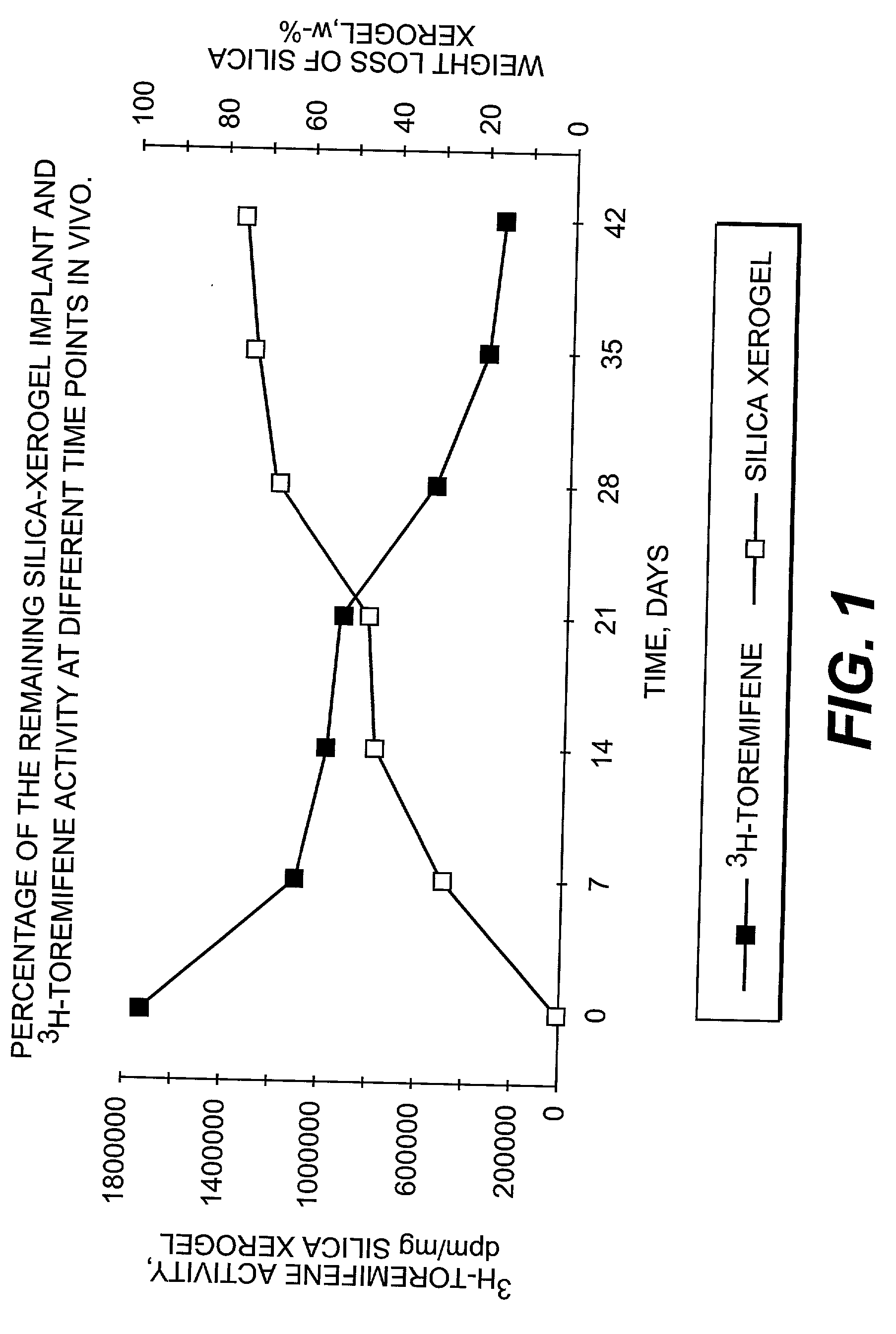Dissolvable oxides for biological applications
a technology of dissolvable oxides and biological applications, applied in the direction of prosthesis, inorganic non-active ingredients, antibody medical ingredients, etc., can solve the problems of inability to achieve any effect, extremely slow reaction rate, and internal stress in the gel
- Summary
- Abstract
- Description
- Claims
- Application Information
AI Technical Summary
Benefits of technology
Problems solved by technology
Method used
Image
Examples
example 2
Production of Silica Xerogel Fibers
[0061] A sol for the fiber drawing purpose was prepared from TEOS, distilled water, HNO.sub.3, and ethanol in 1 / 2.0 / 0.036 / 1.0 ratio. The sol was allowed to form colloidal gel particles for 1 hour at 75.degree. C. before drawing. Silica-xerogel fibers were prepared from the sol using a glass-rod spinneret technique. The fibers were drawn in the spinneret reactor, where the polycondensation occurred at 75.degree. C. The viscosity of the sol at the start of fiber drawing was found to be approximately 10 mPas. The fibers were put into aqueous solution within 48 hours and 4 months later. The fibers were also treated at 300.degree. C. and 700.degree. C. (heating rate 10.degree. C. / h, 2 h at max.T) in addition to the fibers kept at room temperature. The fibers were dissolved into a tris-methylaminomethane-HCl-buffered water or simulated body fluid (pH=7.54, 23.degree. C.; pH=7.40, 37.degree. C.).
[0062] The silica, calcium and phosphate contents were analy...
example 3
Preparation of Silica-Xerogel Fibers Containing Toremifene Citrate
[0070] A sol for the fiber drawing purpose was prepared from TEOS, distilled water, HNO.sub.3 and ethanol in 1 / 2.0 / 0.036 / 1.0 ratio. The sol was allowed to form colloidal gel particles at 75.degree. C. and toremifene citrate (400 mg / ml) was dissolved in the sol after three hours. Before drawing the fibers by glass rod, the silica sol-gel was further allowed to form colloidal particles at 75.degree. C. for 8.5 hours.
example 4
Production of Spherical Spray Dried Silica Xerogel Particles at Room Temperature
[0071] TEOS, distilled water and acetic acid were mixed in 1:14.2:0.5 ratio at room temperature on a magnetic stirrer. After hydrolyzation, the sol was sprayed into air and the droplets were allowed to fall freely onto a polymeric substrate and gelate completely before collecting. The gelated particles were kept in an exciccator for four days before the dissolution test.
[0072] 5,5 mg of gel particles (0,5-1000 .mu.m) were placed in 50 ml of simulated body fluid (SBF) at 37.degree. C. and pH 7.4. The dissolution vessel was under gentle shaking movement during dissolution. Three parallel measurements were performed on each of the three parallel samples after 171, 336 and 504 hours. The particles dissolved 1.9 w-% within a week.
[0073] The spray dried particles (60-200 .mu.m) containing toremifene citrate were prepared by the above method. Toremifene citrate at the concentration of 20 mg / ml was dissolved in ...
PUM
| Property | Measurement | Unit |
|---|---|---|
| temperature | aaaaa | aaaaa |
| temperature | aaaaa | aaaaa |
| diameter | aaaaa | aaaaa |
Abstract
Description
Claims
Application Information
 Login to View More
Login to View More - R&D
- Intellectual Property
- Life Sciences
- Materials
- Tech Scout
- Unparalleled Data Quality
- Higher Quality Content
- 60% Fewer Hallucinations
Browse by: Latest US Patents, China's latest patents, Technical Efficacy Thesaurus, Application Domain, Technology Topic, Popular Technical Reports.
© 2025 PatSnap. All rights reserved.Legal|Privacy policy|Modern Slavery Act Transparency Statement|Sitemap|About US| Contact US: help@patsnap.com


